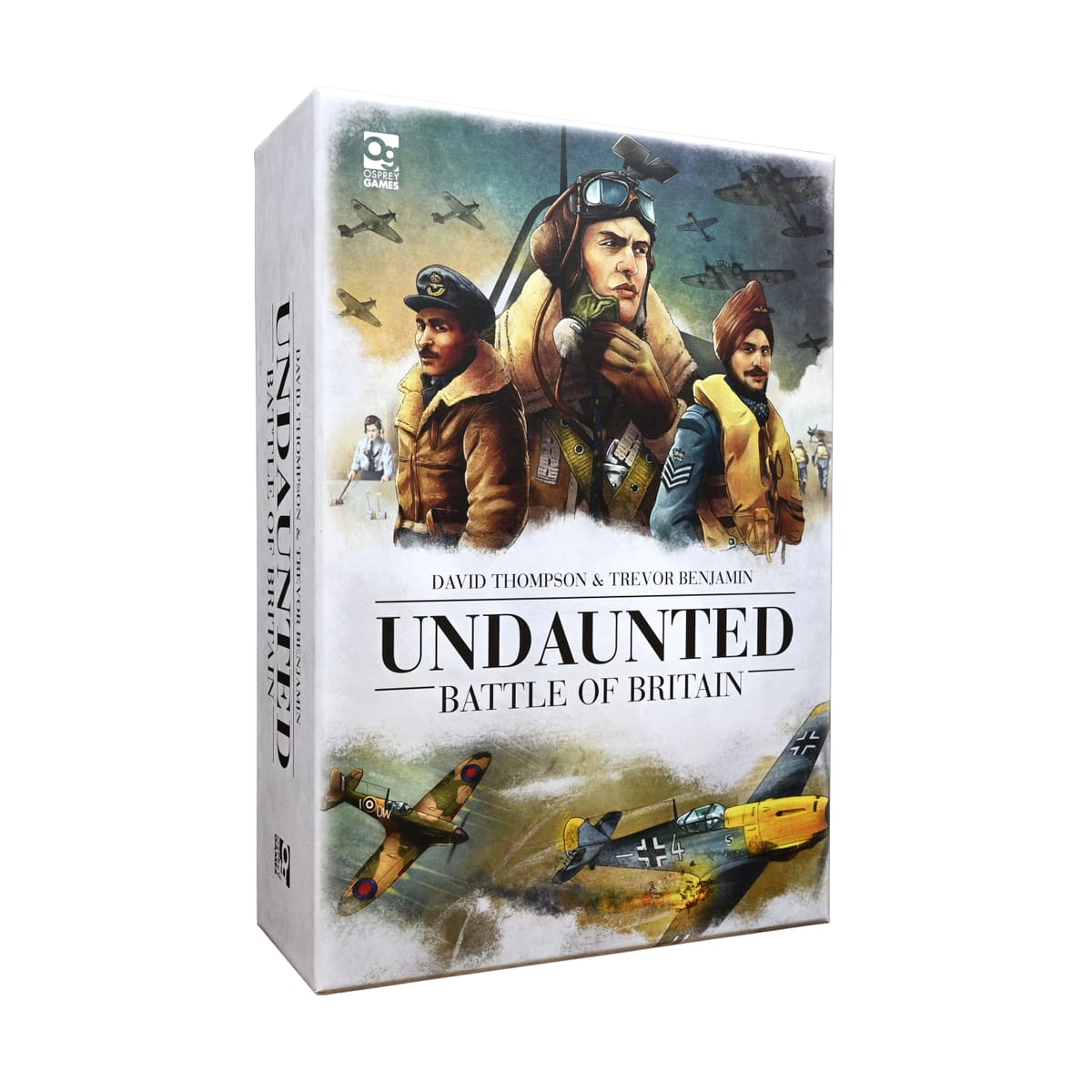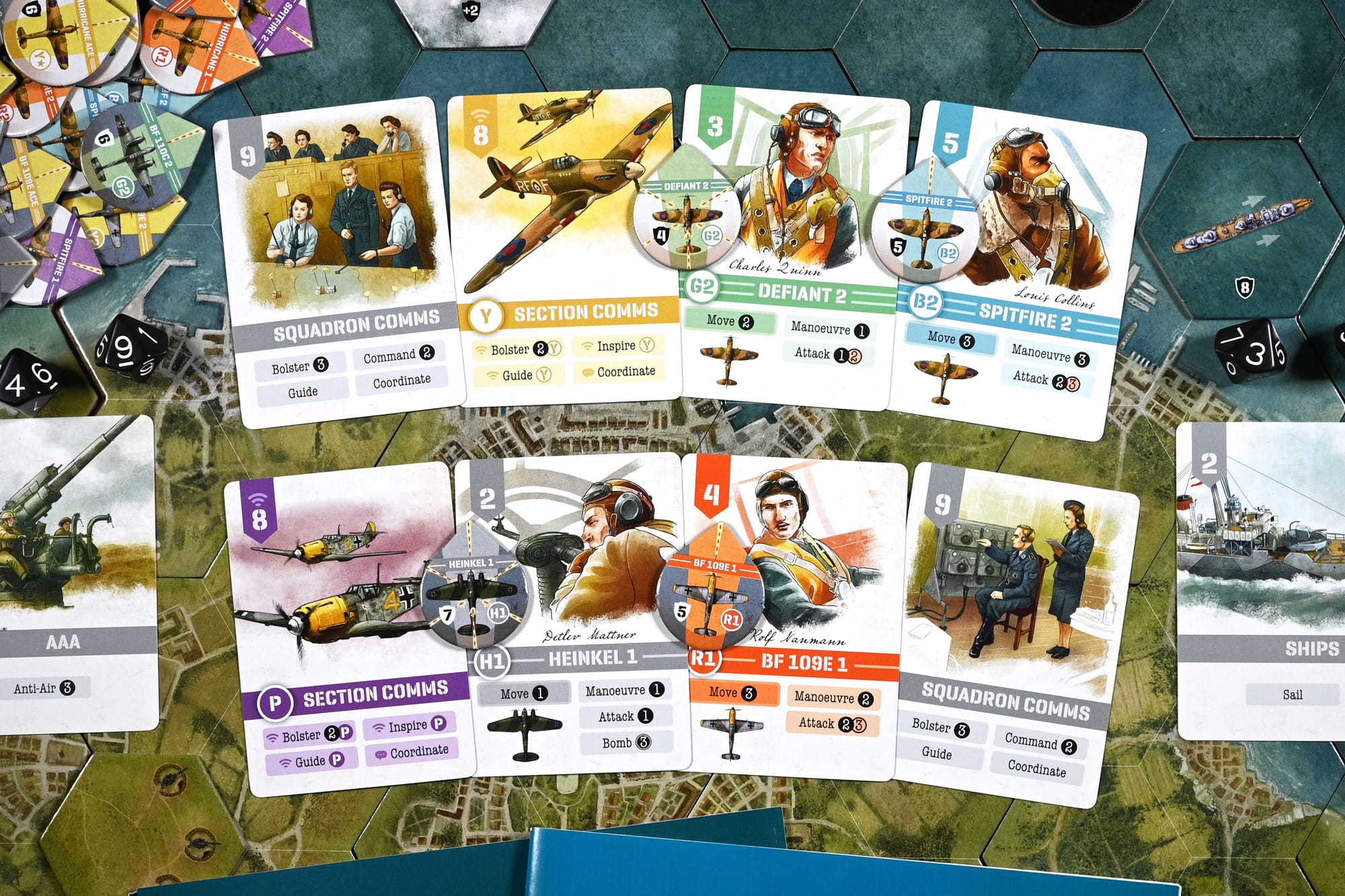
Over the course of three acclaimed wargames David Thompson and Trevor Benjamin’s Undaunted series has taken us from the beaches of Normandy to North Africa’s deserts and onto the frozen meat grinder that was Stalingrad. With the news that the series will be reaching for the stars next year with sci-fi spinoff Undaunted 2200: Callisto, Thompson and Benjamin return, for perhaps one last time, to World War II for Undaunted Battle of Britain.
A much slimmed down affair after the epic Stalingrad, Battle of Britain sees the series take to the skies for the first time as we play through the fateful aerial campaign that saw the Royal Air Force and Luftwaffe duel for supremacy over the Channel. Still, despite leaving terra firma behind gameplay here remains, on the whole, much the same as in previous entries. If it ain’t broke don’t fix it is generally pretty sound advice and Battle of Britain retains the core deck building system that powered previous titles, with just a couple of minor changes made to emulate war amongst the clouds.
The new game features 11 scenarios, that range from straight up dogfights to bombing runs. Each scenario dictates the map, units available to each side and their specific objectives which, generally speaking, involve the RAF seeking to neutralise a certain number of German planes, and the Luftwaffe attempting to blow up stuff up.
All of these scenarios can be played individually or strung together to create a complete campaign that takes you from May 1940 through to September of that year when, unable to secure their objectives, the Germans switched tactics and The Blitz began.

Much like previous Undaunted games the start of each scenario sees both players dealt cards matching the units under their command, normally just one for each plane, alongside a number of communications cards to create a deck. The rest of your cards are then placed ‘in supply’. Unit cards serve a dual function, you need to play one to activate the corresponding plane, but they also represent how much damage you can take. As and when a plane does take a hit you’ll need to discard the corresponding card. If you none are available, not including those still in supply, then for that plane at least the war is over. Communication cards meanwhile can be used to perform a number of special actions, from replaying cards you’ve already used that turn to delving into your supply to add new cards to your deck.
At the start of each turn, once chocks are literally away, both players draw four cards from their deck and promptly sacrifice one, with the highest value card determining who gets the initiative. Then whenever a unit’s card is played you must make some combination of a move alongside either a maneuver or attack. Importantly, these being planes for whom forward motion is generally accepted as being pretty important, if a unit is activated it must move at least one hex. So, if you do take a shot that means you must carry on in the direction you were already facing, even if that means overshooting your target, flying face first into a barrage balloon or placing your unit directly in another plane’s crosshairs.
Even if you do choose a maneuver over combat your options are, as it happens, still pretty limited. There’s no barrel rolls or loop-the-loops to pull off here, rather stately arcs as you wheel your prop-driven planes through the skies. Because of this movement, or more accurately positioning, actually becomes all the more important as you must think ahead and try to anticipate your opponent’s tactics to cut them off, line up the perfect shot or, if you’re the Luftwaffe, plot the perfect bombing run. Make a mistake and it might be a good couple of turns before you can get that plane back in the fight or worse you might find yourself a sitting duck. Further complicating matters all your planes in the same unit need to remain in close proximity to each other or you risk filling up your hand with otherwise useless Discord cards.
As for when the bullets do start flying your planes are, to start off, fairly fragile things. So a key early decision is whether to press on quickly and secure some positional advantage or use your comms card to Bolster your units, pulling more cards out of supply and into your deck to provide your planes with just a little more protection.

It’s honestly all very simple, elegant and after your first few turns pretty intuitive. Even if you’ve never played any other games in the series, you should be able to wrap your heads around it pretty quickly, leave the rulebook untouched and concentrate instead on the serious business of what’s happening on the map, rolling dice and, of course, making triumphant jingoistic sounds as your Spitfire bursts through the clouds right onto the tail of your opponent’s slow moving Heinkel bomber.
Once you have the hang of it games pass in a fairly breezy 45 minutes or so and, bar a couple of occasions, we found most of the scenarios to be fairly even handed affairs with several spectacular last minute reversals as distant, incredibly hopeful potshots winged enemy planes just as they were about to deliver a devastating payload.
It has to be said that after both the literal and emotional weight of Stalingrad, Battle of Britain doesn’t pack quite the same punch. The focus on planes rather than individual soldiers tends to remove some of the visceral impact when a unit is neutralised and, rightly or almost certainly wrongly, popular culture has imbued air combat with an almost knightly grace compared to the sheer grinding horror of urban warfare.
Likewise the game’s much more straightforward scenarios and linear campaign suffer somewhat in comparison to Stalingrad. Had the games been released in a different order these would, of course, all be moot points. Taken in isolation Undaunted Battle of Britain is still a fantastic little wargame and shows that 4 games in to the series it still has some new tricks up its sleeve.
I should point out that of the two I have also found myself much more likely to pull Battle of Britain off the shelf for an impromptu game and despite having played through both sides of the campaign will happily replay the whole thing in the near future.
Undaunted Battle of Britain may lack the epic size and scale of its predecessor, but if this is to be the series’ last visit to World War II then it’s fair to say that Thompson and Benjamin have stuck the landing.
Game Design: David Thompson, Trevor Benjamin
Art: Roland MacDonald
Publisher: Osprey Games
This feature originally appeared in Wyrd Science Vol.1, Issue 5 (Dec '23)

